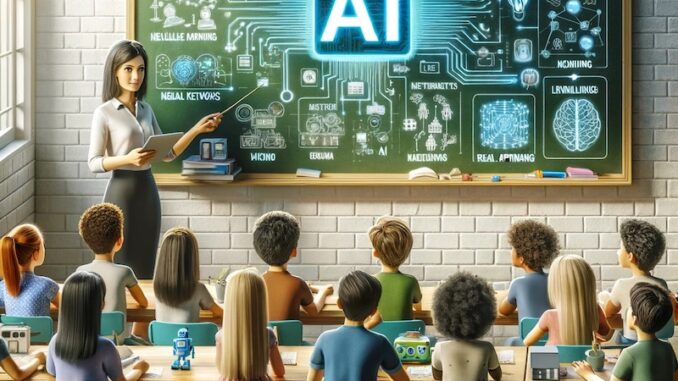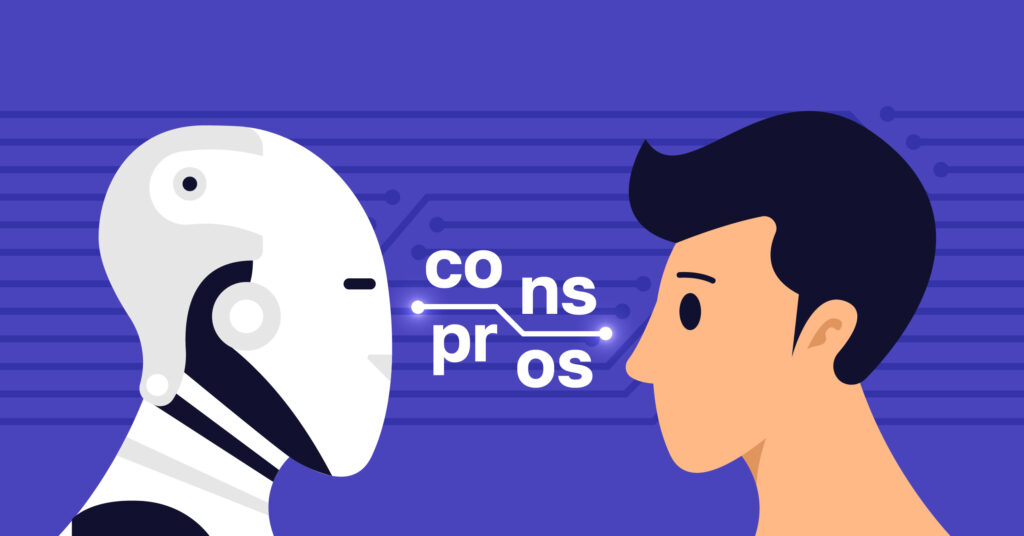

Using AI in the classroom is a must to provide our students with the latest technology and the best resources for their learning. That being said, we also need to need to step back and see how it works and how it sometimes doesn’t work. In this post, I’ll discuss the biases that come with AI, how to deal with those, and how AI fits into two key TCE Threshold Concepts. Plus, I’ll share an AI tool I plan to use with my students and the pros and cons I can see that could come from using this tool.
The Bias Problem in AI and How to Handle It
AI is a great tool and can benefit teachers and their classrooms greatly, but it’s not perfect. Since AI is trained on existing data, it can pick up biases that are already out there, like racial, gender, or cultural biases. For example, if the AI only learns from data that mostly represents one group of people, it might favor that group when it makes decisions. In a classroom, that can show up in ways that could affect how students are assessed or engaged.
To fix this, it is important to make sure that AI tools are just a part of what we do and not the whole picture. It is very important that we check the accuracy of AI’s recommendations and use them as a starting point, not the final word. It is also important to pick AI tools that are transparent about how they work and take steps to reduce bias. This way, we can make sure all of our students have a fair shot, regardless of what the AI might initially suggest.
Connecting AI to Threshold Concepts
Two teaching concepts that I think fit really well with AI in the classroom are “Curriculum is more than standards, textbooks, or courses of study” and “Teaching is/as intellectual engagement.”
- 1. Curriculum is more than standards, textbooks, or courses of study:
This concept highlights the idea that a curriculum is not just a list of required materials or assessments but should foster a broader learning experience that encourages critical thinking, creativity, and deeper understanding. AI can help by providing students with personalized learning experiences that go beyond traditional textbooks. For example, AI tools like ChatGPT can simulate real-life scenarios (like interviews) or analyze data quickly, giving students a more dynamic and interactive way to engage with the material.
AI enables students to explore content in different ways, depending on their needs. Whether it’s through adaptive quizzes that adjust to their learning levels or AI-driven simulations, the curriculum becomes more flexible and student-centered. However, educators must ensure that AI is used to enhance critical thinking rather than replace it with automation. - 2. Teaching is/as intellectual engagement:
This concept stresses that teaching is not just about delivering content but engaging students intellectually and fostering a deeper level of thinking. AI can be a tool to stimulate such engagement, especially when it is used as a partner in learning rather than a simple information provider.
For instance, using AI to help students generate ideas or draft essays can spark deeper discussions about their thought process. AI provides real-time feedback, but it is the teacher’s role to guide students to reflect on and critically assess that feedback. In this way, AI promotes intellectual engagement by encouraging learners to experiment, reflect, and refine their thinking, with the teacher acting as a facilitator rather than just a knowledge source.
CHAT GPT-Check out this blog and video for a quick overview of Chat GPT
Blog:

https://www.awesomescreenshot.com/blog/knowledge/what-is-chat-gpt
Video:

Using ChatGPT as an AI Tool: What I envision working and not working
I plan on using ChatGPT to help my students improve their interview skills. I will have them type out practice interview responses, and then use ChatGPT to give feedback on how their answers sounded. Whether they were clear, concise, or engaging. It will act as a kind of “mock interviewer,” giving students real-time feedback and suggesting ways they could rephrase or strengthen their answers.
Successes I See: ChatGPT will be fantastic for boosting my students’ confidence. They will get immediate feedback and suggestions for improvement, which will help them refine their answers. Plus, it encourages them to practice more on their own, as they can quickly run through different interview scenarios without waiting for my feedback. It also will help them reflect on their own speaking style and polish their communication skills, which are key elements I want to focus on in soft skills training.
Challenges I See: One issue I think may be challenging is that some of ChatGPT’s suggestions aren’t always specific to the student’s field and it will not take into account personal nuances. It’s great for general advice but not perfect for more specialized or industry-specific feedback. Another challenge will be making sure students don’t take its feedback as gospel, because sometimes the suggestions are a bit too formal or robotic.
In Actual Practice: I will build in more one-on-one reflection time with students after they use ChatGPT. I will also encourage them to use the feedback as a conversation starter for deeper reflection rather than just as a to-do list. I also plan to provide more guidance on tailoring the feedback to match their personal style and the specific job they’re aiming for.
https://www.linkedin.com/advice/3/heres-how-you-can-emphasize-key-skills-x7swf
The Pros and Cons of AI in Teaching
AI is definitely changing things up in education, while changes are typically good, there are some flaws too. Here’s what I’ve found so far.
Pros:
- Personalized Learning: AI can adapt to each student’s needs, helping them learn at their own pace and in their own way. This is especially helpful for differentiated instruction.
- Efficiency: AI can handle tasks like grading and attendance, freeing up more time for me to focus on lesson planning and actually working with my students.
- Real-Time Feedback: AI tools can analyze student data quickly and give feedback in real-time, which helps us teachers see where students might need extra help.
Cons:
- Biases: As I mentioned earlier, AI can carry biases from its training data, which can lead to unfair treatment of students if we’re not careful.
- Over-Reliance: There’s a danger that both teachers and students might start depending too much on AI, which can limit critical thinking and creativity.
- Access Issues: Not all students have equal access to the technology needed to use AI, which can widen the gap between students with different backgrounds.

Here is a good blog that also discusses the pros and cons of AI in education:
https://www.classpoint.io/blog/the-pros-and-cons-of-ai-in-education
Final Thoughts on AI in Education
AI is a powerful tool that can change the way we teach and learn, but it needs to be used thoughtfully. By reflecting on our practices and making sure AI is accessible to all students, we can make sure it supports rather than hinders their learning. I’m excited to see how these tools evolve and how we, as educators, can continue to adapt and integrate them in meaningful ways.

I think you make a great point about accessibility in AI. If we don’t teach our students how to use these tools they will be at a disadvantage to those students that can. Have you seen this disparity with any of the students you work with?
Thanks, Aaron. I do find most of the students I work with have the access and knowledge to the latest technologies. I do know this won’t be the case with all students. I want to make sure that I’m aware and able to help those who may not have had the same access.
Thank you for your thoughtful feedback! I completely agree that balancing ChatGPT’s feedback with real-world expertise is key to giving students a comprehensive prep experience. My plan is to combine ChatGPT’s immediate, repetition-based practice with personalized coaching sessions where I can dive into industry-specific nuances and deeper reflections. This way, students benefit from both structured AI practice and hands-on guidance that addresses their unique goals.
I love the graphic you included with the benefits of AI! Such a great visual. I think your plan to use ChatGPT for mock interviews is a great idea! You’ve thought out the pros and cons very well. I wonder if another potential issue would be a lack of experience working with lower level readers or neurodivergent students. Another AI tool that might work well for this purpose that I’ve seen is Final RoundUp AI, which along with being an interviewing platform, also has an AI mock interview function and an AI resume builder. It also gives interview analytics and could be more specific feedback on their domains, since I know that was a concern.
Thank you so much for the suggestion! I’m excited to try Final RoundUp AI. It sounds like a great fit, especially with its interview analytics and targeted feedback, which would really help address the specific skill areas I wanted to improve. It’s going to be so useful for creating a more tailored experience!
Your plan to use ChatGPT for improving interview skills is practical. Immediate feedback is a great way to boost student confidence and encourage practice – especially for the repetition and not the same questions we all practice . I appreciate your approach to using it as a “mock interviewer” to help students refine their answers. Your focus on encouraging reflection and personalizing feedback is crucial for improvement. Addressing the potential challenges, like the need for industry-specific advice.
How do you plan to balance ChatGPT’s feedback with your own expertise to ensure students get well-rounded guidance?